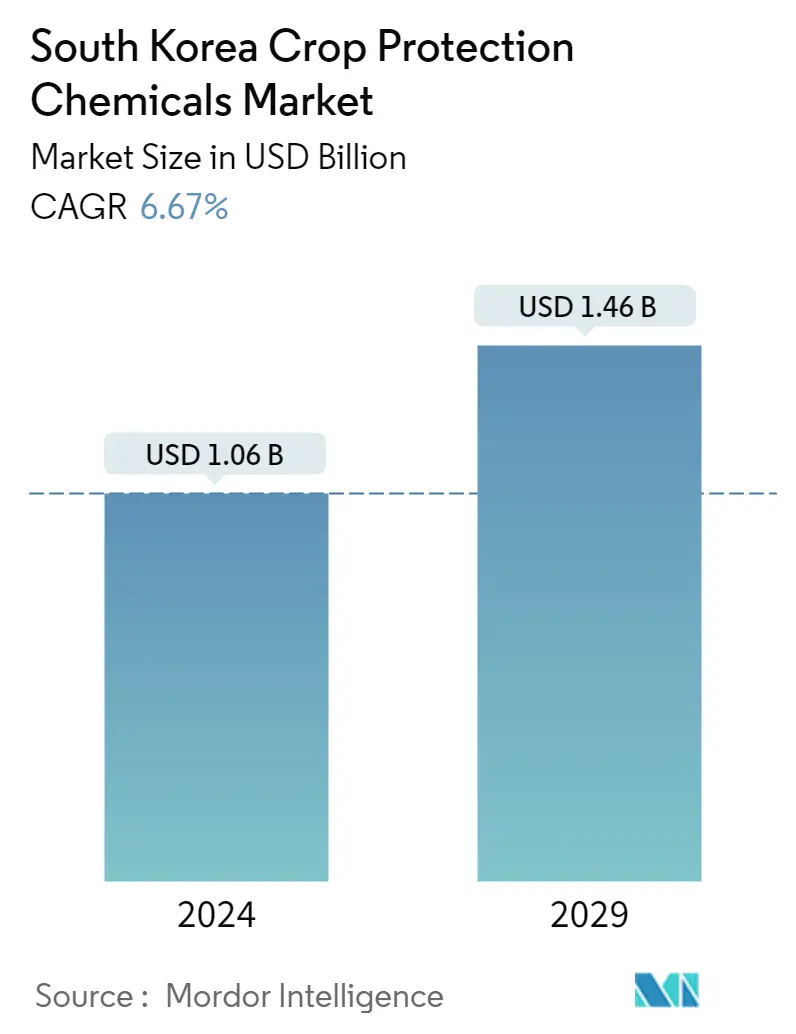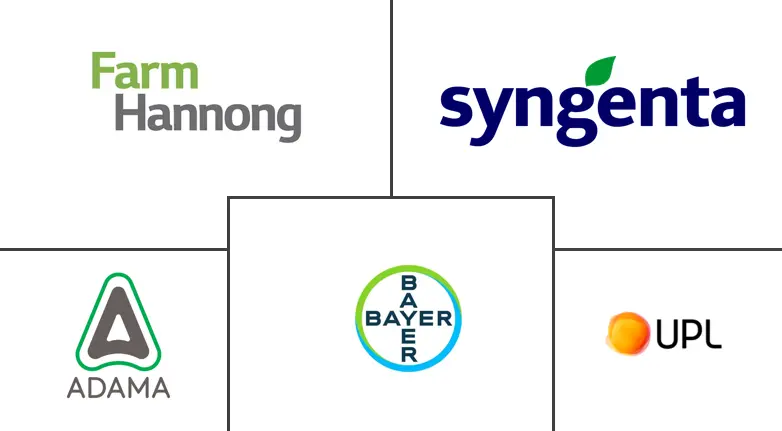Market Size of South Korea Crop Protection Chemicals Industry

| Study Period | 2019 - 2029 |
| Base Year For Estimation | 2023 |
| Market Size (2024) | USD 1.06 Billion |
| Market Size (2029) | USD 1.46 Billion |
| CAGR (2024 - 2029) | 6.67 % |
| Market Concentration | High |
Major Players
*Disclaimer: Major Players sorted in no particular order |
South Korea Crop Protection Chemicals Market Analysis
The South Korea Crop Protection Chemicals Market size is estimated at USD 1.06 billion in 2024, and is expected to reach USD 1.46 billion by 2029, growing at a CAGR of 6.67% during the forecast period (2024-2029).
- In South Korea, rice is the most cultivated grain, which accounts for about 90% of the total grain production and over 40% of farm income. In addition, other crops include vegetables, soybean, other oilseeds, and fruits and vegetables that consume the bulk of crop protection chemicals. South Korea is a mountainous country, with less than 22% of the land area available as arable land. Hence, Korean farmers emphasize maximizing productivity per unit of land, and efficient crop protection solutions play an essential role in achieving efficient productivity.
- Major players are innovating with new products based on safety and regulatory issue in the market and eco-friendly products. For instance, Adama expanded its proprietary nematicide, Nimitz, to Japan, the world's fourth-largest agricultural market, and also to South Korea and Taiwan. Adama has secured regulatory approval for the product in these markets for various crops, among them sweet potatoes, fruiting vegetables, melons, and others, in addition to the existing product registrations in several other markets, such as the US, Mexico, Australia, and Israel. It offers a highly effective and simple-to-use solution to farmers for the control of nematodes, along with a low toxicity and eco-toxicity profile compared to other alternatives currently on the market.
- Korean agricultural authorities introduced the Positive List System (PLS), accelerating the rapid growth of biological and eco-friendly products in Korea. This new regulation, which aims to promote pesticide residue safety, stipulates that farmers should strictly follow product labels and guides in terms of application on crops, application frequencies, application rate, and other important safety precautions. As a result, in many sectors, farmers couldn't use chemical pesticides that were used conventionally for a long time without a label list. In addition, these chemical pesticides were replaced by bio-pesticides. This will boost the market to grow in the coming years.
South Korea Crop Protection Chemicals Industry Segmentation
Crop protection chemicals constitute a class of agrochemicals used to prevent crop destruction by insect pests, diseases, weeds, and other pests. The South Korean crop protection chemicals market is segmented by chemistry (into synthetic crop protection chemicals and biopesticides), product type (into herbicides, insecticides, fungicides, and other crop protection chemicals), and crop type (into grains and cereals, pulses, and oilseeds, commercial crops, fruits, and vegetables, and other crop types). The report offers market size and forecasts in terms of value in USD million for all the above segments.
| Chemistry | |
| Synthetic Crop Protection Chemicals | |
| Biopesticides |
| Product Type | |
| Herbicides | |
| Insecticides | |
| Fungicides | |
| Other Crop Protection Chemicals |
| Crop Type | |||||
| |||||
| Pulses and Oilseeds | |||||
| |||||
| Fruits and Vegetables | |||||
| Other Crop Types |
South Korea Crop Protection Chemicals Market Size Summary
The South Korean crop protection chemicals market is poised for significant growth, driven by the country's unique agricultural landscape and regulatory environment. With rice as the dominant crop, accounting for a substantial portion of grain production and farm income, the market is characterized by a high demand for efficient crop protection solutions. The limited arable land in South Korea necessitates maximizing productivity, making crop protection chemicals essential. The market is witnessing innovation, particularly in eco-friendly and bio-based products, as companies like Adama expand their offerings to meet regulatory standards and consumer preferences. The introduction of the Positive List System (PLS) has further accelerated the adoption of biological and eco-friendly products, as it mandates strict adherence to pesticide residue safety, prompting a shift from conventional chemical pesticides to bio-pesticides.
The South Korean government's emphasis on environmental sustainability and the promotion of Environment-Friendly Agriculture (EFA) policies are reshaping the market dynamics. These policies encourage the use of registered agrochemicals and impose strict penalties for non-compliance, fostering a shift towards biological products and reducing reliance on synthetic chemicals. The increasing resistance of pests to chemical insecticides has also driven farmers towards bio-insecticides. The market is further bolstered by the growing trend of organic farming, supported by government initiatives, which have led to a notable reduction in chemical fertilizers and pesticides. The market is fairly consolidated, with major players like Syngenta, Bayer Korea Ltd, UPL Ltd, Adama Korea Co. Ltd., and Farm Hannong competing on product quality and strategic expansions to capture a larger market share.
South Korea Crop Protection Chemicals Market Size - Table of Contents
-
1. MARKET DYNAMICS
-
1.1 Market Overview
-
1.2 Market Restraints
-
1.3 Porter's Five Forces Analysis
-
1.3.1 Bargaining Power of Suppliers
-
1.3.2 Bargaining Power of Buyers/Consumers
-
1.3.3 Threat of New Entrants
-
1.3.4 Threat of Substitute Products
-
1.3.5 Competitive Rivalry
-
-
-
2. MARKET SEGMENTATION
-
2.1 Chemistry
-
2.1.1 Synthetic Crop Protection Chemicals
-
2.1.2 Biopesticides
-
-
2.2 Product Type
-
2.2.1 Herbicides
-
2.2.2 Insecticides
-
2.2.3 Fungicides
-
2.2.4 Other Crop Protection Chemicals
-
-
2.3 Crop Type
-
2.3.1 Grains and Cereals
-
2.3.1.1 Rice
-
2.3.1.2 Barley
-
2.3.1.3 Other Grains
-
-
2.3.2 Pulses and Oilseeds
-
2.3.3 Commercial Crops
-
2.3.3.1 Cotton
-
2.3.3.2 Other Crops
-
-
2.3.4 Fruits and Vegetables
-
2.3.5 Other Crop Types
-
-
South Korea Crop Protection Chemicals Market Size FAQs
How big is the South Korea Crop Protection Chemicals Market?
The South Korea Crop Protection Chemicals Market size is expected to reach USD 1.06 billion in 2024 and grow at a CAGR of 6.67% to reach USD 1.46 billion by 2029.
What is the current South Korea Crop Protection Chemicals Market size?
In 2024, the South Korea Crop Protection Chemicals Market size is expected to reach USD 1.06 billion.

